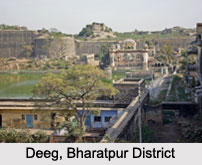 Deeg is town in the Bharatpur District of North Western state of India, Rajasthan. This town has many palaces, forts, gardens and fountains along with the historical and mythological significances. Deeg is mainly popular for Deeg Palace which was erected during the medieval era of Rajput rule and it has more than 900 fountains, which operate now for the tourism twice in a year during a festival that was held in the month of February and September.
Deeg is town in the Bharatpur District of North Western state of India, Rajasthan. This town has many palaces, forts, gardens and fountains along with the historical and mythological significances. Deeg is mainly popular for Deeg Palace which was erected during the medieval era of Rajput rule and it has more than 900 fountains, which operate now for the tourism twice in a year during a festival that was held in the month of February and September.
Location of Deeg
Deeg is located to the north of Bharatpur District and is situated towards the northern part of Agra. Deeg is easily accessible from Delhi and Agra. Deeg is about 98 kilometers from Agra.
History of Deeg
History of Deeg is defined from the time of Lord Krishna, as Deeg is the place of yatras of Lord Krishna, associated with the legends of Govardhana. Deeg also has its reference in Skanda Purana. During the reign of Badan Singh, in 1722, Deeg had been the initial capital city of Jat state of Bharatpur. During the rule of Suraj Mal the capital was shifted from Deeg to Bharatpur and as a result Deeg became the second capital city of Bharatpur. Before 18th century Deeg was a village of eastern Rajasthan and was also a part of the Mughal territory in the Agra province. In later years, Deeg became the place of conflict between Jats, Marathas and British East India Company.
 Geography of Deeg
Geography of Deeg
The geographical position of Deeg is about 27.47 degrees North and 77.33 degrees East. The average elevation of Deeg is about 174 m.
Demography of Deeg
According to the Population Census in the year 2001, Deeg has a population of about 40,826. The male literacy is 71 percent and the female literacy rate is 49 percent.
Culture of Deeg
The people of Deeg are mostly Hindu. As they are traditional in nature they are more closely associated with religion. The festivals held during the month of September occupy an important place for the people of Deeg and during this time, Deeg becomes lively with colour.
Tourism in Deeg
Deeg is a town of Islamic architecture. Apart from the beautiful gardens that encircle the magnanimous Havelis of Deeg there are many other architectural heritages of Rajput era, which attract tourists in large numbers. Gopal Bhawan till date is one of the most brilliant palaces in Deeg. The reflection of the Gopal Bhawan in the Gopal Sagar is absolutely spellbound. There are many other havelis in Deeg. Some of them are Hardev Bhawan, Kishan Bhawan, Keshav Bhawan and Nand Bhawan. Deeg fort and Deeg Palace and Suraj Bhawan are the popular attractions here.



















